
Troubleshooting Common Plant Problems
Kiwi Nurseries Ltd. has years of experience in identifying and troubleshooting common diseases and issues that we face in our climate. To help ensure the success of our customer’s projects we want to share that knowledge with you. Under each title below you will find information to help you identify and treat the following common plant problems. If you still have concerns about an issue with your plant, we welcome all of our customers to Contact Us with any further questions.
Our Printable PDF
 What is Black Knot?
What is Black Knot?
Black Knot is a fungus (apiosporina morbosa) which is characterized by its black, tar-like lumpy growths affecting the Prunus family, such as Cherry, Plum, Apricot, Chokecherry, and Mayday trees. It is an airborne fungus which overwinters in the knots, then releases spores in the early spring of the infection’s second season, typically during rain. The spores are distributed long distances on wind currents and through rain splashing. Black Knot typically affects new green twigs, but can also affect mature branches or trunks, especially if physical damage is present. If left un-checked, these black galls will continue to grow and will eventually girdle the branch or trunk and kill it. The stress caused to the tree can also make it susceptible to other diseases and can affect the overall health of the tree. Black Knot is highly contagious.
Symptoms
Stage 1 : The branch will turn light brown and start swelling. These swellings can be difficult to notice.
Stage 2 : The swelling will continue to grow. As it matures, it will turn into visible hard, black galls.
Stage 3 : As the galls continue to grow internally and externally, it can eventually kill the branch and tree.
How to Manage Black Knot
All infected branches must be pruned out of the tree at least one foot from the infection site. To prevent the spread of further infection, disinfect the pruners with bleach between each cut. When removing the cut-off branches, be careful not to rub them against healthy branches. Immediately place infected branches into a garbage bag.
Diseased wood must be eliminated immediately, by burning it or putting the closed bag of infected branches in the garbage. Monitor regularly to make sure it does not come back. If you spot black knot in your neighbour’s tree, then your tree has a greater chance of becoming infected.
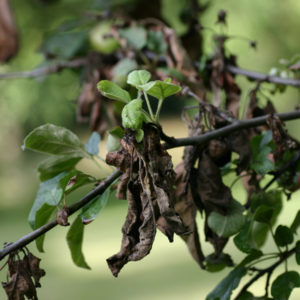 What is Fire Blight?
What is Fire Blight?
Fire Blight is a contagious disease caused by the spreading of the pathogen Erwinia amylovore, a bacterium affecting apples, pears, and some other members of the family Rosaceae. Honeybees and other insects, birds, rain and wind can transmit the bacterium to susceptible plant tissue. Injured tissue is highly susceptible to infection, including punctures and tears caused by plant-sucking or biting insects. Once deposited, the bacterium enters the plant through open stomata and causes blackened, necrotic lesions, which may also ooze a viscous fluid, especially in humid weather. The disease spreads most quickly during hot, wet weather and is dormant in the winter when temperatures drop. Infected plant tissue contains viable bacteria and can return upon warm weather in the following year.
Symptoms
Symptoms may appear on blossoms, fruits, shoots, or branches of an affected tree. All symptoms are above ground and are typically easy to recognize. Symptoms on blossoms result in a dull, gray-green appearance and eventually tissues will shrivel and turn black. The base of the blossom and young fruit show similar symptoms as infection spreads. Shoots can show similar symptoms but develop much more rapidly. A “Shepherd’s Crook” can be seen when the tip of the shoot wilts, and diseased shoot leaves typically have blackening along the mid-vein and then die. Initial infection of blossoms and shoots can spread to larger tree limbs. Branches will darken and become water soaked. Advanced infection develops cracks in bark and a sunken surface. Wood under the bark will become streaked with black discoloration. Immature fruit forms water-soaked lesions and later turned black. Bacterial ooze can be found on these lesions. Severe infections result in fruit turning entirely black and shriveling.
How to Manage Fire Blight
All infected branches must be pruned out of the tree at least one foot from the infection site. To prevent the spread of further infection, disinfect the pruners with bleach between each cut. When removing the cut-off branches, be careful not to rub them against healthy branches. Immediately place infected branches into a garbage bag.
Diseased wood must be eliminated immediately, by burning it or putting the closed bag of infected branches in the garbage. Monitor regularly to make sure it does not come back. If you spot Fire Blight in your neighbour’s tree, then your tree has a greater chance of becoming infected.
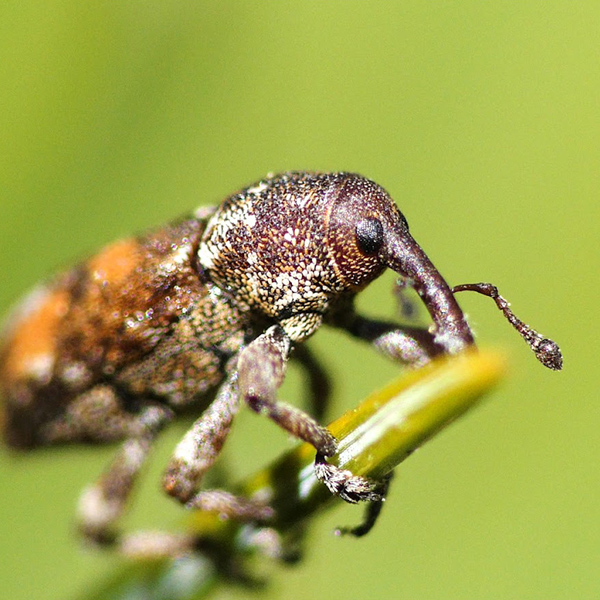 What is a White Pine Weevil?
What is a White Pine Weevil?
The white pine weevil is a pest that causes extensive damage to many types of evergreen trees. it is also known as the Engelmann spruce weevil and the Sitka spruce weevil. This harmful pest attacks at least 20 different species of trees. it prefers Easter White, Jack, Scots pine and spruce trees.
Symptoms
Droplets of resin oozing from tiny feeding holes in the leader stem early in spring. These can be hard to notice. A shepherd’s crook in the leader is a classic sign that an evergreen is infested with the white pine weevil, although other pest attacks may result in similar symptoms. The curling and death of the leader of a tree indicates the presence of larvae in the stem. THe needles on the affected stem will turn yellowish-green, then reddish-brown and will eventually fall off. The damage generally appears in mid-June or early July.
How to Manage White Pine Weevil
Pruning infested trees can be an effective control if its done as soon as possible after the first signs of infestation are noticed. you must prine out infested branches. Prune close to the topmost unaffected whorl of branches.
Infested wood must be eliminated immediately, by burning it or putting the closed bag of infested branches in the garbage. Monitor regularly to make sure it does not come back. If your neighbour’s tree is infested, then your tree has a greater chance of becoming infested.
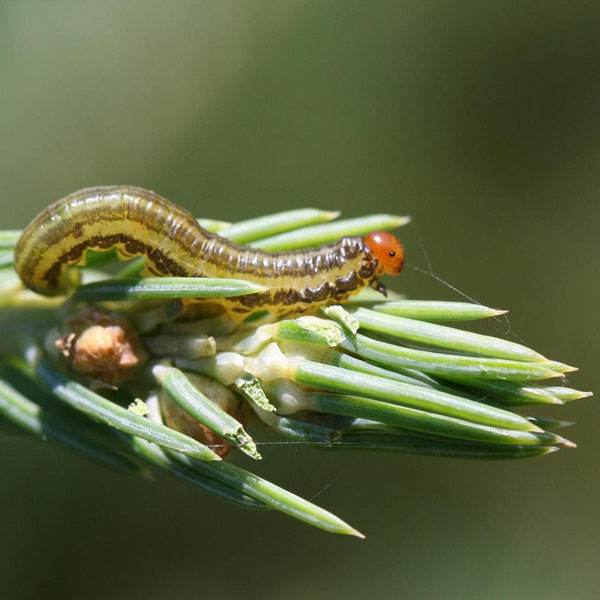 What is a Yellow Headed Spruce Sawfly?
What is a Yellow Headed Spruce Sawfly?
The yellow headed spruce sawfly is a pest that causes extensive damage to many types of evergreens, mainly spruce trees. Their eggs are pearly-white and ovate. The larva causes the damage to the trees. The yellow headed spruce sawfly prefers young open trees.
Symptoms
Once the eggs hatch, the larvae eat small parts of the new needles. As they develop they will strip the needles from the branch and go after older needles. There will be multiple sawfly larvae on each tree.
By July infested trees appear ragged and yellow- brown near the top. Heavily-infested trees may be completely stripped of foliage. If not treated for a few years, the sawfly can kill the tree. Sawfly is infectious!
How to Manage Yellow Headed Spruce Sawfly
If the sawflies are only on a few small trees, they can be controlled by picking off and destroying the larvae when they are first noticed. For shelterbelts or large trees, chemical control is needed.
The following insecticides can be used; acephate, carbaryl, diazinon, dimethoate, malathion or permethrin. Insecticide application should be made when damage is first noted.
Trees can recover from sawfly provided they do not become re-infested. It may take several years to fully recover.
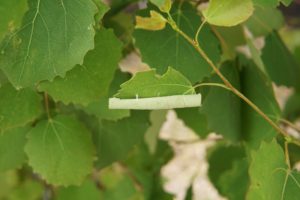 What are Leaf Rollers?
What are Leaf Rollers?
Leaf rollers include a few different species of butterflies and moths. The larvae shelter themselves by rolling up leaves around their bodies in a cylinder, with a silk plugging the ends.
How to Manage Leaf Rollers
The damage they cause is primarily aesthetic, with the disfigured leaves often noticeable if found near eye level. The tree is not usually harmed, as they are not voracious eaters. The leaves or branches can be pruned to get rid of heavily impacted areas of the tree. There is not a reliable chemical control, as the larvae are well protected in their shelters.
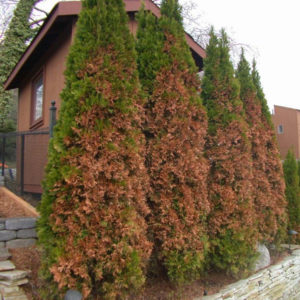 What is Sunscald?
What is Sunscald?
As much as we love the beautiful sunny winter weather, some plants such as evergreens can be susceptible to sunscald if not properly protected. Sunscald can occur if snow near the base of an evergreen is left untouched. The smooth, white surface of snow can act like a mirror reflecting the sun’s harsh rays onto nearby evergreens causing damage to the foliage.
How to Prevent Sunscald
In order to protect them, tromp down the snow around the base of these plants. This makes the surface of the snow uneven, allowing the sun to reflect in different directions, minimizing the concentration of the harsh rays.
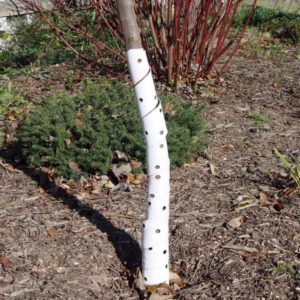 How do Rabbits, Mice & Voles Damage Trees?
How do Rabbits, Mice & Voles Damage Trees?
Rabbits, mice and voles are known to frequently damage the lower 2-3 feet of some trees during winter months, by chewing off the bark around the base of the trunk. When the bark is removed from a tree trunk it effectively disrupts the tree’s ability to carry energy from the leaves down to the roots. Eventually the roots starve and the tree dies.
Rabbits : With the ability to stand on their hind legs, they tend to gnaw on bark from a few inches above the ground surface to as high as two to three feet up the trunk.
Mice & Voles : These smaller vermin, on the other hand, are adept at burrowing beneath the snow and sometimes even beneath loose soil or mulch, to eat away at the tree bark without ever being noticed.
How to Prevent Winter Animal Damage to Trees
Move Your Mulch : In the fall, push your mulch back away from the base of the tree trunk by a few inches to prevent mice and voles from burrowing in unnoticed.
Wrap Your Trees : Fall is also the time to wrap the trunk of your trees with a plastic tree wrap from the base of the trunk to about three feet up the trunk.
TIP : Be sure to remove the protective wrap in the spring!
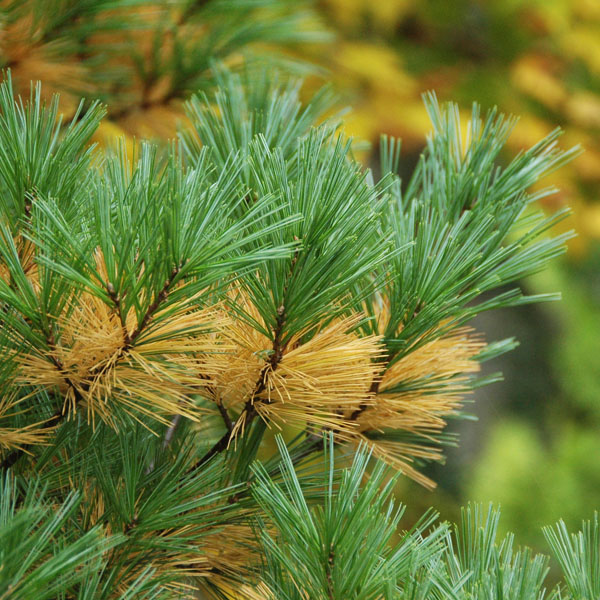 What is Fall Needle Shed?
What is Fall Needle Shed?
Yellowing of interior needles in the fall is a normal occurrence for evergreen trees. Conifers do not keep their growth of needles on their inside branches and shed them naturally in the fall. The discoloration, which affects the older needles close to the trunk occurs in late August, and can continue until freeze up. The amount of shedding can be greater if the tree has been placed under stress caused by droughts, flooding or newly dug trees. These needles are not replaced and this is why evergreens are bare of needles near the trunk and there is usually a carpet of needles under the tree.
 |
| 